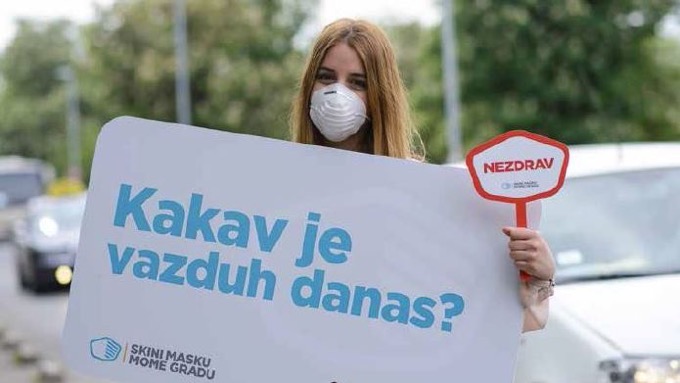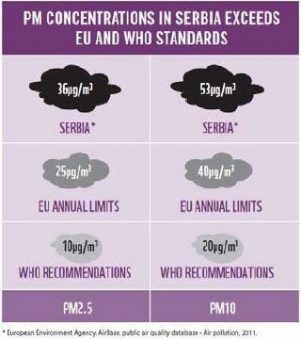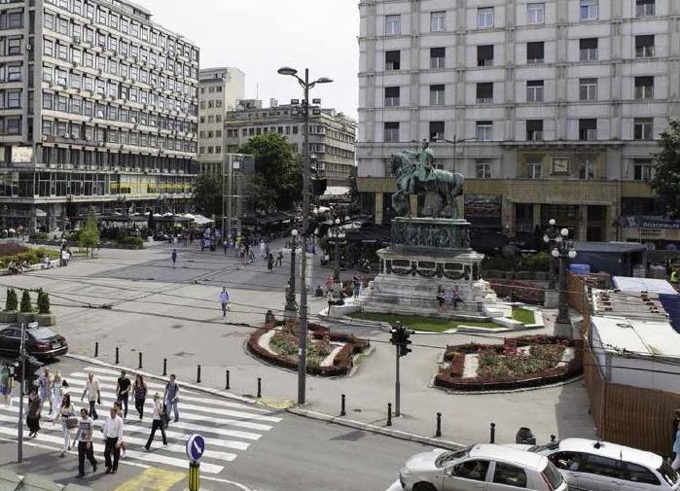
The numerous consequences of air pollution, including the contribution to mortality of one million people per year worldwide, are becoming a hot topic in Serbia. Exposure to air pollution is associated with a huge number of acute and chronic diseases, from irritations through respiratory illnesses to cardiovascular diseases, and contemporary science has made a connection between the air pollution and diabetes. The effects of air pollution on health are well documented, though mixtures of pollutants in the air may be complex.
Air pollution is a mixture of liquid and solid phases; a mixture of gaseous, volatile, semi-volatile substances and their ratio is quite variable. The main pollutants are suspended particles such as ozone, nitrogen dioxide, sulphur dioxide, methane, mercury and soot obtained by combustion of hydrocarbon gases. There is numerous research on the impact of these pollutants on our health.
In an interview with Vlatka Matkovic Puljic from the non-governmental organization Health and Environment Alliance we found out in what way the air quality monitoring should be performed, whether the pollution measurements are properly carried out and to what extent are HEAL’s measurements different from the measurements of public institutions.

Vlatka Matkovic Puljic was born in Croatia, lives in Brussels and is employed by HEAL. She deals with the air pollution in the Balkans. Her main focus is industrial sources of pollution, given the fact that industry is one of the main air pollutants. Before joining HEAL, she worked for different organizations including Zagreb University Hospital for Infectious Diseases, “CARE International” and Croatian Institute for Public Health. By vocation, she is a defectologist, and she holds a doctorate degree in the field of public health at the University of Zagreb, Faculty of Medicine.
The air pollution is a global problem which you can see and feel in Belgrade, too. The data of the World Health Organisation according to which more than 7,000 people die due to air pollution exposure, can serve as evidence. These data put Serbia on the second place in Europe according to the number of premature deaths due to air pollution. In Serbia, there are more than 3,300 cases of premature deaths annually due to only one pollutant – thermal power plant on coal. At a global level, 6.5 to 7 million people die due to air pollution. If this number of deaths were to be transferred into money, we would come to the information that the consequences of air pollution from thermal power plants cost the country between one and four billion euros annually.
“Most people who live in urban areas, live in the polluted environment. The largest sources of pollution are traffic, thermal power plants on coal, house heating on coal, and wood. The total of 50 percent of particle pollution in Serbia come from coal-fired power plants, then from house furnaces, and in the third place are some other sources of pollution”, says Vlatka Matkovic Puljic.
Air quality in Serbia represents a huge problem. Measurements show that citizens across the country inhale the air that is considered harmful to health.  For example, the concentrations of PM2.5 and PM10 are significantly higher than the limit values which the European Union and World Health Organisation have set. In the report on air quality from 2013, it is stated that the annual limit value of PM10 particles, which is 40 μg/m3, was exceeded during the course of the year in most locations. During 2013 the quality of air in wider urban areas of Belgrade, Bor, Užice, and Smederevo was rated as III category, which means it was over-polluted. According to the data, 73% of the population in urban and urban-industrial areas were potentially exposed to concentrations of pollutants that are above the reference level in the same year.
For example, the concentrations of PM2.5 and PM10 are significantly higher than the limit values which the European Union and World Health Organisation have set. In the report on air quality from 2013, it is stated that the annual limit value of PM10 particles, which is 40 μg/m3, was exceeded during the course of the year in most locations. During 2013 the quality of air in wider urban areas of Belgrade, Bor, Užice, and Smederevo was rated as III category, which means it was over-polluted. According to the data, 73% of the population in urban and urban-industrial areas were potentially exposed to concentrations of pollutants that are above the reference level in the same year.
In urban areas, in addition to pollution from thermal power plants that pollute the entire country, other pollutants are also present. In Belgrade, that is traffic, and the other problem is thermal power plants that are located near Belgrade and they emit large quantities of different pollutants such as nitrogen oxides, sulphur dioxide, and other particle pollution.
HEAL carried out an action for measuring personal exposure to polluted air with the help of small mobile devices “AirBeam” which was proved to be accurate according to the analyses conducted in the USA. There was an open invitation for candidates who wanted to carry these measuring devices and the action was launched in Belgrade and Novi Sad. The idea was that volunteers measure their daily exposure to air pollution, from their exposure when going to work (on foot, by car or bicycles) to staying indoors or during a city walk, etc. The device “AirBeam” measures the pollution caused by PM2.5 particles and it operates on photo laser method which is not that sophisticated as a monitoring station that takes a sample of dust on which basis radioactivity and the origin of pollution can be analysed (whether it comes from a thermal power plants, traffic or some other source).
“Air monitoring in Serbia is done and it is relatively good but the number of measuring stations is not sufficient. There are only few monitoring stations for PM2.5 in entire Serbia but only the data from the monitoring station located in New Belgrade are taken for the annual calculation instead of taking the data from all monitoring stations. Through this project, we tried to figure out what is the difference between personal exposure to particle pollution in relation to what the monitoring stations have recorded.”
from the monitoring station located in New Belgrade are taken for the annual calculation instead of taking the data from all monitoring stations. Through this project, we tried to figure out what is the difference between personal exposure to particle pollution in relation to what the monitoring stations have recorded.”
While she was in Belgrade in June this year, Vlatka measured the concentration of particles in the city and the average concentration of PM particles from Voždovac to the city centre was 37 micrograms per cubic meter (μg/m3), and the highest was 57. According to the World Health Organization if you live in a place in which the concentration of PM2.5 particles is 12 μg/m3 it is considered to be healthy, while the concentration of up to 35 μg/m3 is considered to be unhealthy for sensitive groups such as kids, elderly, pregnant women and people with sensitive respiratory system. When the limit of 55 μg/m3 is exceeded, the environment is considered to be extremely unhealthy and the risk exposure is high. At the same time when Vlatka was measuring air pollution for PM2.5 particles, two monitoring stations recorded the data for PM2.5 – and they were 11 μg/m3 and 14 μg/m3. The first monitoring station is located in the wider city centre and the latter in New Belgrade. Also, the volunteers who carried these devices with them found out that the highest pollution of these particles was in cafés in which smoking is allowed – the concentration of PM2.5 particles was 180–190 μg/m3**.
“With this project, we wanted primarily to involve citizens in the active measuring of air quality and monitoring of their personal exposure to air pollution in everyday life, and thus to raise the awareness of what (un)healthy air is,” Vlatka explained to us.
Health and Environment Alliance (HEAL) has urged Serbian authorities to make e orts to purify the air in our country within the Campaign “Unmask my City” which was conducted in Belgrade to mark the World Day against Asthma in 2017. The campaign was supported by the Serbian Ministry of Health and the experts from the Medical School in Novi Sad who conduct a pilot study on the exposure to suspended PM2.5 particles. “Unmask my City” is a global initiative of health workers, led by HEAL, for the improvement of air quality and the reduction of greenhouse gases emissions. Activists of initiatives have invited the city authorities all around the world to adhere to the WHO’s air quality guidelines and to adopt the appropriate policy and program. The global campaign “Unmask my City” was also launched in Warsaw, Adana, Istanbul, Iskenderun, London, Salt Lake City, Chennai, Ahmedabad and Sao Paolo.

Prepared by: Nevena Djukic
* All the data are taken from the official report on Air Pollution and Health in Serbia prepared by NGO HEAL (Health and Environment Alliance).
This content was originally published in the eighth issue of the Energy Portal Magazine ECOHEALTH, in November 2017.

